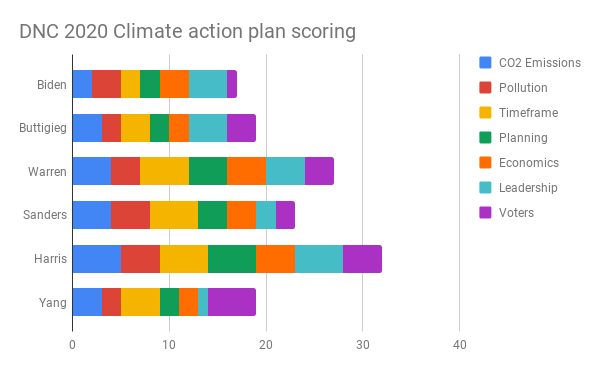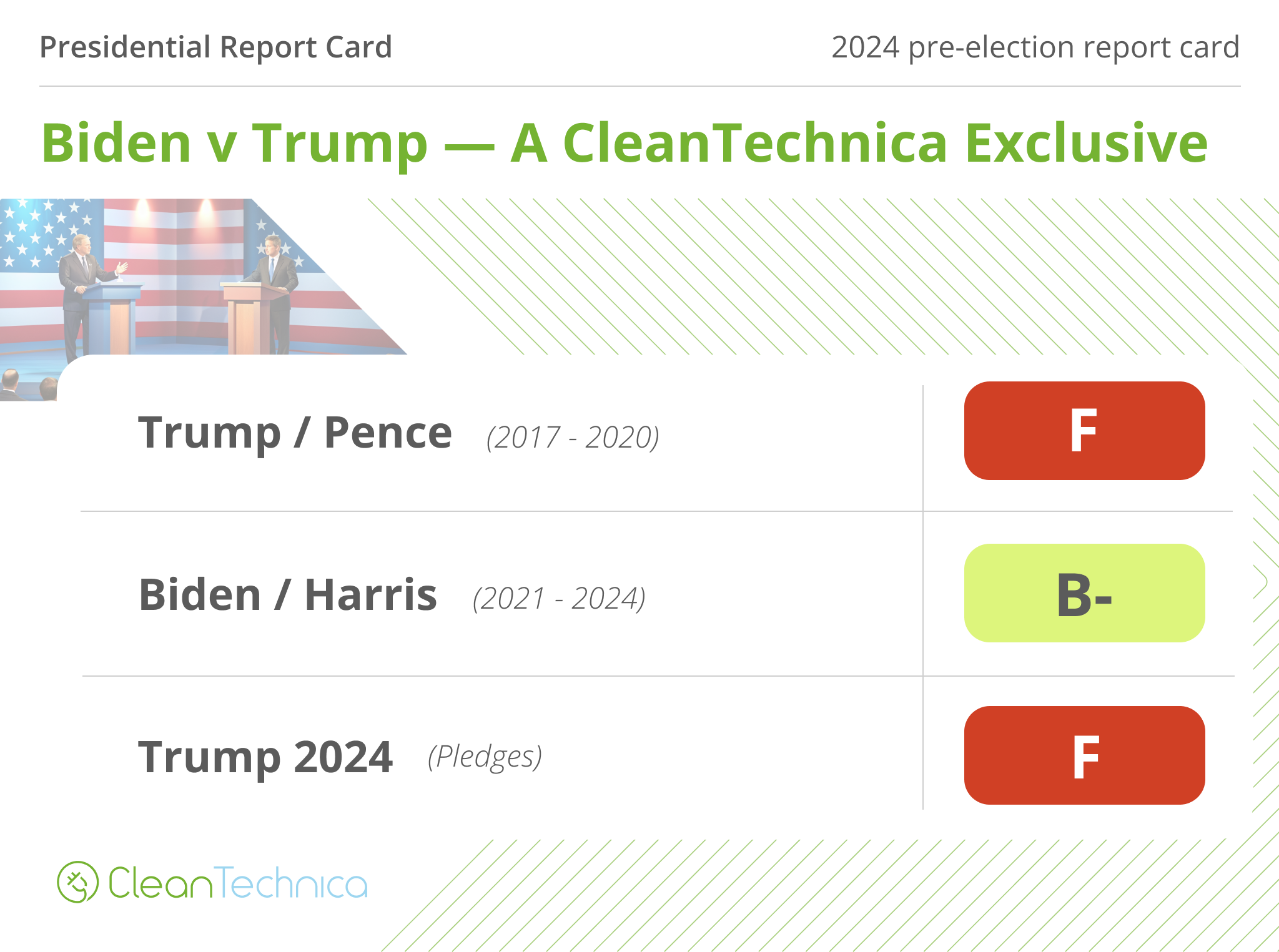US Election 2024: Harris/Walz Ticket A Big Upgrade For US Climate Action
Recently, I published a seven-part series on the Trump/Biden matchup, focusing on climate-relevant actions in Trump and Biden Administrations, and the campaign rhetoric and promises in 2024. Of course, Biden dropped out as the series was closing out and Harris became the candidate. Further muddying the waters, Tim Walz was named her running mate. And so, a return to Election 2024, with a look at what a Harris/Walz administration might mean for climate action.
It’s worth casting our minds back to the last presidential election cycle. During 2020, the USA saw a remarkable, open, clear, and respectful debate across the political spectrum, with candidates who were left and right of center socially and fiscally, as well as candidates who focused on Wall Street reform, social justice and cross-the-aisle solutions. It was a bravura display of American democracy at its best, a long running debate between potential leaders committed to the country about how best to shape its response to the rapidly changing world.
That event was the Democratic presidential primary debates. Sadly, the Republican Party was missing in action from useful policy discussions, its much diminished and fractured body having been hijacked by Donald Trump’s populism. But for people actually concerned with real issues facing America and meaningful alternatives for policy, the economy, the climate, and foreign policy, it was a glorious oasis in a fractious political cycle.

At the time, I tracked the major candidates and a couple of interesting outliers like Andrew Yang with a seven-part assessment of their climate actions platforms. Not particularly sharp eyes will note that Kamala Harris’ climate action planned scored highest, followed by Warren. As I said at the time:
Harris’ plan is aggressive & well-balanced, with clear dates, targets, & action items, and is aimed at building a coalition of allies
The strongest candidate on climate in 2020 has been Vice President for the past four years of the Biden administration as many consequential executive actions and pieces of legislation have been shepherded through the thorns of a divided Democratic Party with its fossil-fuel extremist wing, best represented by coal millionaire Joe Manchin, and a Republican Party so committed to obstructionism that they refused to pass legislation that they agreed with and had sponsored.

Understandably, America’s climate actions only rated a B- in my assessment just before the electoral fates picked up the chess board and threw it into a blender with some margarita mix while a soundtrack by Charli XCX pushed a lot of the voting public onto the dance floor.
If anything, Harris’ insights into climate impacts are higher than they were four years ago, as she had the southern border file as Vice President. While this is missing from 99.99% of coverage of the US southern border challenges, it’s a climate-change story as much as it is anything. Climate change is disrupting economies in Central America, causing displacement of poorer citizens who have lost their homes to extreme weather events or lost their livelihoods to drought or flooding. Further, as with all vulnerable regions impacted by climate change, regional conflict is increasing.
There are an estimated 1.5 million internally displaced persons in Central American countries, and hundreds of thousands who have crossed out of their countries seeking greener, or at least not flooded or bone-dry, pastures. That’s out of a total population of 51 million in those countries, so represents a rather large percentage. It would be like 10 million Americans roaming homeless within the USA, streaming out of, for example, the bone-dry US Southwest into California and northern states, requiring refugee camps and upending political and regional perspectives.
Both Biden and Harris were fully aware of this in 2020. One of Biden’s platform planks as a nominee candidate was to build a high-voltage direct current transmission (HVDC) backbone down through Central America, connecting the Americas with a clean energy corridor. This was in part in aid of countering China’s Belt & Road Initiative, but also to bring economic growth and opportunity to Central America, bringing work and money to soak up displaced people, keeping most of them from trying to cross the southern border. That plank didn’t survive into his Presidential platform, where it morphed into a domestic HVDC transmission grid, copying Sanders’ plank on the subject. Domestic politics were more important than foreign politics on this file, and nuanced policies like dealing with root causes fell by the wayside. (Now eleven of twelve South American countries and four of seven Central American countries are members of China’s BRI.)
But Harris’ approach to the border was a root-cause approach. She spent a lot of time in Central America working on initiatives that would reduce displaced people there, rather than militarizing the southern border as Republican’s had pretended to do and as Trump is again promising to do, this time by mobilizing the National Guard on US soil over the restrictions in the Posse Comitatus Act. As such, Harris is even more strongly aware of the implications of extreme weather events on vulnerable populations inside and outside of the USA, and more strongly aware of the implications for national security and an intertwined global economy. This didn’t lead to signature legislation, something that being in the Vice-Presidential role tends to limit regardless, but it will inform any Harris Presidency.
In her 2024 campaign, Harris has emphasized a strong commitment to continuing and expanding on the climate action policies initiated under the Biden administration. Harris has pledged to further advance the objectives of the Inflation Reduction Act, which is considered a landmark climate law providing substantial funding and tax incentives to support the transition to renewable energy. To a certain extent, this reflects that some avenues are already settled in terms of US actions, and that Harris can’t campaign on significant changes to the IRA, as it was brought in while she was Vice President.
Harris is also advocating for more aggressive measures, including enforcing stricter penalties on polluters and enhancing the prosecution of fossil fuel companies, something she has strong prior credentials on from her time doing much the same in California before entering federal politics. While she previously supported a ban on fracking during her 2019 presidential campaign, she has since softened this stance, reflecting a more moderate approach to balance environmental goals with certain economic concerns, especially in key battleground states like Pennsylvania.
One key thing missing from Harris’ 2020 platform and recent statements is a commitment to a carbon price. She was wishy washy in 2020, only promising to engage communities in discussion of one, and has made no commitments to one since becoming the Democratic Presidential candidate.
However, America already has greenhouse gas pricing on two key pollutants and a third gas had legislation introduced under the Biden administration, legislation that was axed before it got anywhere.
In the last days of Trump’s presidency, December 27th, 2020, the bipartisan American Innovation and Manufacturing (AIM) Act was signed into law. It included an emissions cap and a market mechanism for high global-warming potential refrigerants, mostly hydrofluorocarbons (HFC), which are commonly used in freezers, refrigerators, heat pumps, and air conditioners. They can be 4,300 times as potent a greenhouse gas as carbon dioxide, so a little goes a long way. The Kigali Amendment to the Montreal Protocol from 2016 brought about an international treaty to replace them with low-GWP refrigerants.
While the Trump administration didn’t ratify the Kigali Amendment, it did support the AIM act. However, the Trump administration did also gut the Environmental Protection Agency (EPA), which was responsible for implementation of AIM, so the likelihood of it having an impact in a second Trump term was low. The Biden administration brought new life to the EPA and the HFC market is operating. Further, the Biden administration ratified the Kigali Amendment. Regardless of what else happens after November, it’s likely the HFC price will stay intact.
A Harris administration would be reasonably certain to look at the HFC price and consider adjusting the cap and pricing to be more aggressive, regardless of anything said on the campaign trail.
The Biden administration brought in a price on leaking methane, the high–global warming potential gas that makes up most of natural gas. The USA has the ugly distinction of having the highest methane leakage from its oil and gas industry of all the countries in the world, rather like otherwise reasonably attractive people who still smoke.
The methane price is $900 per metric ton of leaked methane, equivalent to a carbon price of $36 per metric ton (even America uses metric sometimes). It’s going to go up in 2025 and 2026, barring a change in administration and political alliances, peaking at $1,500 per ton, equivalent to a carbon price of about $65 per ton. That’s above Canada’s carbon price at present, while below both Canada’s 2030 target price — at risk in its own election cycle in the coming year — and the European Union’s current price. Of course, there are loopholes big enough in the methane price that oil tanker trunks can happily be driven through them, so the price’s actual impacts are somewhat symbolic at present.
A Harris administration would be reasonably certain to look at the methane price, work to close loopholes, ensure ongoing enforcement, and potentially raise the price in the future beyond its current cap.
And so, on to the grandfather of greenhouse gases, carbon dioxide. It really is the grandfather. It was isolated and characterized in the 1830s. In the 1850s, Eunice Foote — an often overlooked female American scientist — proved that it was a greenhouse gas. In the 1890s, Swedish scientist Svante Arrhenius worked out the likely contribution to atmospheric temperatures of burning fossil fuels, and was remarkably accurate. In the 1970s, Exxon’s scientists, along with a lot of other scientists not working for the firm, figured out that burning fossil fuels was causing climate change and that it was a bad thing, so Exxon promptly muzzled them and started the fossil fuel industry’s tradition of spending millions on disinformation and lobbying to prevent climate action. In the 1980s, climate change due to burning fossil fuels, along with a few lesser human contributions, was established as being real and serious beyond any reasonable doubt, and the International Panel on Climate Change was established.
One thing has been consistent since then, that putting a price on emitted carbon dioxide was a fundamental lever in addressing climate change. Naturally, Europe and a few other countries did this early and have been adjusting their mechanisms regularly to make them more effective. Also naturally, pricing carbon is a challenge in the United States, which prefers to throw money at often head-scratching “winners,” blue hydrogen and carbon capture incentives being yet more subsidies for the overly subsidized, absurdly profitable, highly destructive fossil fuel industry.
This played out during the Biden administration. Carbon pricing legislation was drafted and in committee. It was framed as an anti-China bill, something which seems to have broad bipartisan support at present. The premise was that it was a carbon border adjustment, one potentially to include Canada and Mexico inside the USMCA trade sphere. However, the fine print had a domestic price on carbon. Among other recidivist Democratic politicians, this was bad for Joe Manchin’s coal-oriented business — $600,000 a year in proceeds for him personally, per public records — so clearly wasn’t remotely acceptable. As a result, the carbon price died in committee, unable to get even enough Democratic support, let alone Republican.
However, things are changing. Assuming some degree of rational voting in November — a frankly dubious proposition, but one can hope — a reasonable collection of Democratic politicians will be elected, including Harris. The Democratic political landscape will have changed, as Joe Manchin isn’t running again, having feathered his nest, his children’s nests, his grandchildren’s nests, his second-cousin-twice-removed’s nests, etc. with coal profits–purchased down feathers. Presumably, he’ll move to sitting on fossil fuel boards and raking in more money, but one can hope he’ll enter the 21st century at some point. Regardless, he won’t be blocking the Whip anymore on climate action.
Further, there have been a lot more extreme weather climate disasters in Red States, as well as a massive growth of renewables, and a lot of battery and electric vehicle jobs as well. While US fossil fuel export revenues have skyrocketed in the past years, so have actually good paying jobs and opportunities that are aligned to climate action. Coal burning is plummeting, while coal exports have only soaked up some of the loss. The coal lobby is shrinking, a lot of America’s oil and gas emissions are in other countries, so not subject to a domestic carbon price, and there’s money in them thar solar farms. It’s quite likely that more Republicans would support a carbon pricing mechanism, especially as it would put another burden on China, float Red State investments in clean technology, and enable US firms to remain competitive in Europe.
Having floated a serious bill in Biden’s administration, a Harris administration would be highly likely to return to this file and much more likely to find a path through the political thickets.
After all, as Churchill said, “You can always count on Americans to do the right thing—after they’ve tried everything else.”
But what about Harris’ new running mate, Tim Walz? Not being a hardcore observer of the minutia of American politics — disregarding tens of thousands of words typed on the subject over multiple election cycles — Walz wasn’t on my radar screen. (Editor’s note: He wasn’t on anyone’s radar screen. —Zach) Like probably most Americans, my first thought was, “Oh, a geriatric white guy to give comfort to the pasty Boomer demographic.” And, like most Americans, I was surprised to find out that he was only six months older than Harris.
That wasn’t the only surprise. He’s a small town Minnesota hunter, yet he realized the serious challenges of unfettered access to weapons and is a strong gun control advocate. He’s a straight white guy from Middle America, yet he was one of the founders and teacher advisors to the Gay Straight Alliance at the high school he taught at, while also coaching the football team. He and his team are the ones who injected “Weird” into national political discourse to great effect.
Side note: It’s interesting to me that no one has made note of the book “he WEIRDest People in the World: How the West Became Psychologically Peculiar and Particularly Prosperous by Joseph Henrich. It’s modern cultural Darwinism with Protestantism as the enabling force for all the good in the world, and of course Western culture being the most “evolved,” with advances in all other cultures being due to adopting Western cultural patterns. Like many Western analyses these days, it significantly oversimplifies and makes much more binary shame- vs. guilt-based societies. Unsurprisingly, it was much more positively received in Europe and the USA than in the rest of the world. Although, the rest of the world did appreciate the aspects of the book that admitted that the West was weird.
And Walz has great climate credentials. Since taking office in 2019, Walz championed ambitious environmental policies, including the passage of legislation mandating that Minnesota’s power sector achieve 100% carbon-free electricity by 2040. Under his leadership, the state streamlined the energy permitting process to accelerate the development of renewable energy projects. Walz’s administration prioritized environmental justice, working to ensure that the benefits of clean energy and climate resilience reach all communities, particularly those historically burdened by pollution. His climate initiatives garnered national attention, aligning with broader federal efforts to combat climate change and setting a precedent for other states to follow.
Of course, Walz also wins a key polling question hands down: “Would you rather have a beer with X or Y?” Ask that of the average American about any pairing of politicians that includes Walz, and the dad who doesn’t get that turkey isn’t a vegetarian food, goes for annual new fairground rides with his daughter Hope, and clearly likes to hang out in rumpled clothes wins hands down.
While he hasn’t had an opportunity to shape policy for the Harris/Walz ticket to any great degree yet, he’s strongly aligned with Harris on climate change being real, serious, caused by us, and something that we have to address aggressively.
Overall, the Harris/Walz ticket represents a significant climate action upgrade from the Biden/Harris ticket. 538 poll averaging puts Harris ahead of Trump in most swing states, so there is the potential for a rational outcome in November after all. And with a young, energetic ticket, the down-ticket races are undoubtedly a lot more interesting too.
The world is watching. America made an inexplicable and horrifying decision with Trump in 2016 from the world’s perspective, and the following four years proved that judgment to be accurate. Then sanity returned in 2020, although the House and Congress weren’t nearly Blue enough. Perhaps this year enough Americans will be smelling the forest fire smoke and flooding rot for the executive and legislative arms to be united in engaging rationally with the greatest challenge of the 21st century (as well as dealing with the corrupted judicial branch).
It may be a Brat Summer, but with luck, it will be an Adult Swim Fall. The world needs more from the United States than a B- on climate.

Chip in a few dollars a month to help support independent cleantech coverage that helps to accelerate the cleantech revolution!
Have a tip for CleanTechnica? Want to advertise? Want to suggest a guest for our CleanTech Talk podcast? Contact us here.
Sign up for our daily newsletter for 15 new cleantech stories a day. Or sign up for our weekly one if daily is too frequent.
CleanTechnica uses affiliate links. See our policy here.
CleanTechnica's Comment Policy

